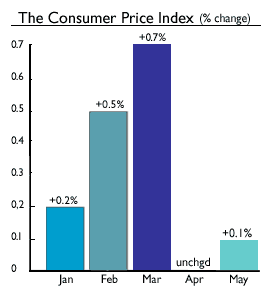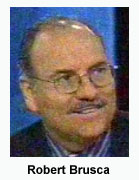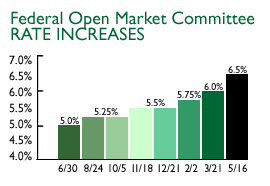|
Consumer prices edge up
|
 |
June 14, 2000: 1:18 p.m. ET
May Consumer Price Index rises 0.1%, but up 0.2% excluding food and energy
By Staff Writer M. Corey Goldman
|
NEW YORK (CNNfn) - Retail prices rose at a moderate pace in May, offering more evidence to investors that the robust pace of the U.S. economy isn't fueling faster inflation -- a scenario expected to persuade Federal Reserve officials to defer an interest rate increase later this month.
 The Consumer Price Index, the government's main inflation yardstick, rose 0.1 percent in May, the Labor Department reported Wednesday, below the 0.2 percent increase economists had expected and a shade above the flat reading registered in April. Excluding volatile food and energy costs, prices rose 0.2 percent, matching forecasts and April's 0.2 percent gain. The Consumer Price Index, the government's main inflation yardstick, rose 0.1 percent in May, the Labor Department reported Wednesday, below the 0.2 percent increase economists had expected and a shade above the flat reading registered in April. Excluding volatile food and energy costs, prices rose 0.2 percent, matching forecasts and April's 0.2 percent gain.
The latest numbers offered more hope to investors that the Fed's series of rate increases, which began a year ago, soon may come to an end. The economy expanded at a 5.4 percent pace in the first quarter, below the scorching 7.3 percent growth posted in the fourth quarter of 1999, but still above what analysts and Fed officials deem a non-inflationary rate of growth. The second-quarter numbers will be tallied at the end of June, with preliminary data being released in July.
"You should start to wonder whether there should be a statute of limitations on analysts arguing there is inflation down the road," said Oscar Gonzales, an economist with John Hancock Financial Services in Boston. "I don't think you can rule out a rate hike in August, but this should add some flexibility for the Fed's policy makers."
Fed officials next meet June 27-28 to discuss monetary policy and the progress of the economy.
A temporary reprieve?
May's inflation numbers were the latest piece of evidence pointing to moderating economic growth and tame inflation, a combination the Fed has been looking to achieve through its series of rate increases over the past year. Other reports have shown faltering job growth, slower manufacturing output, stagnating wages, subdued spending, and slowing home sales.
 That's how most economists are viewing the numbers. But Robert Brusca, chief economist with Ecobest Consulting, told CNNfn's Before Hours that Fed policy makers likely aren't viewing the recent spate of economic data the same way. With inflation running at a 3.1 percent annualized pace and with only one month of employment contraction to ponder, the relatively recent evidence of an economic slowdown may not be enough to keep Fed Chairman Alan Greenspan and Co. from raising rates again. (445KB WAV) (445KB AIFF) That's how most economists are viewing the numbers. But Robert Brusca, chief economist with Ecobest Consulting, told CNNfn's Before Hours that Fed policy makers likely aren't viewing the recent spate of economic data the same way. With inflation running at a 3.1 percent annualized pace and with only one month of employment contraction to ponder, the relatively recent evidence of an economic slowdown may not be enough to keep Fed Chairman Alan Greenspan and Co. from raising rates again. (445KB WAV) (445KB AIFF)
Indeed, one piece of evidence almost anyone with a car or truck can attest to is the recent rise in gasoline prices. Prices at the pumps once again have exceeded $2 a gallon in some parts of the country, an increase that likely will filter its way into the June inflation numbers, according to Sherry Cooper, chief economist with brokerage BMO Nesbitt Burns Inc.
In addition, while U.S. employment growth posted its first decline in more than four years last month, the job market remains robust, with employers being pressured to pay their workers more in wages and benefits to keep them on the job. That could fuel higher prices in the months ahead as companies pass on those higher costs to consumers.
Fed on hold?
"Coming on the heels of the recent spate of weaker economic reports, the better than expected inflation news will probably cause the Fed to leave interest rates unchanged at their June FOMC meeting," said Mark Vitner, economist with First Union National Bank. "It is still way too soon, however, to conclude that the Fed is done."
 That wasn't how financial markets saw it. The Dow Jones industrial average and Nasdaq composite index both posting gains by mid-morning on expectations the Fed will hold its benchmark fed funds rate at 6.5 percent at the month-end meeting. Bonds posted a mixed reaction to the report, with most securities with durations of 10 years or less unchanged. That wasn't how financial markets saw it. The Dow Jones industrial average and Nasdaq composite index both posting gains by mid-morning on expectations the Fed will hold its benchmark fed funds rate at 6.5 percent at the month-end meeting. Bonds posted a mixed reaction to the report, with most securities with durations of 10 years or less unchanged.
Declining energy prices helped keep the overall index steady last month. Overall energy costs dropped 1.9 percent in May, with gasoline prices falling 3.5 percent. A 2.7 percent drop in tobacco prices along with a drop in clothing prices also kept the overall CPI in line. Offsetting the declines were increases in prices for food, housing, cars and airline tickets.
Since May 1999, consumer prices have risen 3.1 percent; prices excluding food and energy have gained 2.4 percent.
Fed's Parry encouraged
Fed Bank of San Francisco President Robert Parry said Wednesday he was encouraged by the benign May CPI report in that it shows inflation isn't picking up. "We have pretty low inflation," Parry told a Fed seminar in San Diego. "As a matter of fact, it came out today and continued at a relatively low level, at least by the Consumer Price Index," he said.
 Parry, a voting member of the Fed's policymaking Federal Open Market Committee, said he was encouraged by economic data in April and May that showed the U.S. economy might be beginning to slow after a year of Fed credit tightening. But he urged caution, saying it would take more than a month or two of statistics to confirm a change in the growth trend. Parry, a voting member of the Fed's policymaking Federal Open Market Committee, said he was encouraged by economic data in April and May that showed the U.S. economy might be beginning to slow after a year of Fed credit tightening. But he urged caution, saying it would take more than a month or two of statistics to confirm a change in the growth trend.
The CPI is the last major economic indicator the Fed will see before its next meeting. Later Wednesday, the Fed will release its Beige Book, an economic survey conducted eight times a year and released two weeks before each of its monetary policy meetings. The report is generally used as a reference for Fed officials in their deliberations about monetary policy and interest rates.
Separately, the Commerce Department reported Wednesday that sales at factories, wholesalers and retailers declined 0.4 percent in April, the largest drop in almost three years, as inventories sitting on shelves grew, another indication that consumer spending is beginning to slow down. 
|
|
|
|
|
 |

|

